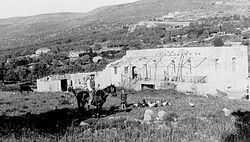Motza

Motza (or Motsa) (Hebrew: מוֹצָא) is a neighbourhood in the western edge of Jerusalem, Israel, located 600 metres above sea level. In the Judean Hills, surrounded by forest, it is a relatively isolated place connected to Jerusalem by the Jerusalem-Tel Aviv highway and the winding mountain road to Har Nof. Originally the first modern Jewish village outside the city, Motza is located on the site of a Biblical village of the same name, mentioned in Joshua 18:26.[1] It was the scene of a violent attack in the 1929 Palestine riots.[2][3][4]
History
.jpg)

In 1854, farmland was purchased from the nearby Arab village of Qalunya (Colonia) by a Baghdadi Jew, Shaul Yehuda, with the aid of British consul James Finn. Jewish families from Jerusalem joined the enterprise, one of which ran a tile factory, among the earliest industry in the region. Despite preparation for groundbreaking and deciding on the name Motza for the place, legal complications prevented settlement, though a traveller's inn was established at the site in 1871 by Yehoshua Yellin, a notable figure of the Old Yishuv. He built the inn on the foundation of an older Roman building. A B'nai B'rith official eventually solved the legal problems, and finalized a deal in which the Motza residents could pay for their plots in long-term payments.[2][5]

When Theodor Herzl visited Palestine in 1898, he passed through Motza, which then had a population of 200. Captivated by the landscape, he planted a cypress tree on the hill. After he died in 1905, at the ago of 45, it became an annual pilgrimage site by Zionist youth, who planted more trees around Herzl's tree.[6]David Remez named the sanatorium opened in the village Arza, or cedar, even though it was a different species of tree.[7] During World War I, Herzl's tree was cut down by the Turks who were leveling forests for firewood and supplies.[6]
The children of Motza were educated by author and researcher Moshe David Gaon, father of future star Yehoram Gaon. The village was the only Jewish presence in the area, as the other Jewish villages of Kfar Uria and Hartuv were far to the west among the Judean foothills.[2][8][9] The Hope Simpson Report in 1930 mentions a farmer by the name of Broza who owned a flourishing orchard in Motza.[10]
In 1933 the villagers founded the neighbouring Upper Motza (Motza Illit). Jerusalem's expansion incorporated Motza into the city.
In December 1948, United Nations General Assembly Resolution 194 recommended that "the built-up area of Motsa" be included in the Jerusalem "Corpus separatum", which was to be detached from "the rest of Palestine" and "placed under effective United Nations control". However, like other provisions of Resolution 194, this was never carried out in practice, and Motza became part of the State of Israel.
1929 murders
Despite good relations with neighbouring Arab communities,[citation needed] the village was attacked during the 1929 Palestine riots. Several residents of Kolonia attacked an outlying house belonging to the Maklef family, killing the father, mother, son, two daughters, and their two guests. Three children survived by escaping out a second-story window; one, Mordechai Maklef, later became Chief of Staff of the Israeli Army. The attackers included the lone police officer and armed man in the area, as well as a shepherd employed by the Maklef family. The village was subsequently abandoned by Jews for a year's time.[4]
Refugees from Motza sent a letter to the Refugees Aid Committee in Jerusalem describing their plight and asking for help: "Our houses were burned and robbed...we have nothing left. And now we are naked and without food. We need your immediate assistance and ask for nothing more than bread to eat and clothes to wear." [11]
Landmarks
Motza was home to one of Israel's oldest wineries, the Teperberg Winery, then called Efrat, until its move to Tzora.[12] In 2006, the Yellin and Yehuda families helped restore Joshua Yellin's original home, among the oldest and most derelict buildings at the site.[13]
See also
References
| Wikimedia Commons has media related to Motza. |
- ↑ National Campus for the Archeology of Israel
- ↑ 2.0 2.1 2.2 Motza, Atarot, and Neveh Yaacov
- ↑ Ancient Motza
- ↑ 4.0 4.1 Segev, Tom (1999). One Palestine, Complete. Metropolitan Books. p. 324. ISBN 0-8050-4848-0.
- ↑ לגרב ימ בכרב ימ
- ↑ 6.0 6.1 Planting from the remains
- ↑ http://www.feeljerusalem.com/videos/modern_pilgrimage.html
- ↑ Herzl’s Tree
- ↑ סיפור הפרברים: חמישה אתרים בשולי ירושלים
- ↑ Hope Simpson Report
- ↑ Jewish memorabilia to be auctioned in Jerusalem, Haaretz
- ↑ Rogov, Daniel (2012). The Ultimate Rogov's Guide to Israeli Wine. Toby Press. p. 550.
- ↑ עבודות שיפוץ ושימור לבית משפחת ילין במוצא
External links
- Motza history on Haim Zippori centre for community education (Hebrew)
- Motza Valley (Hebrew)
Coordinates: 31°47′38.11″N 35°10′6.45″E / 31.7939194°N 35.1684583°E
